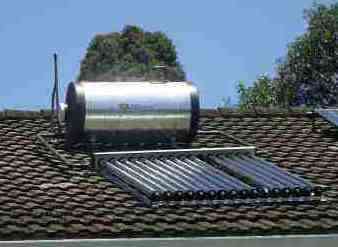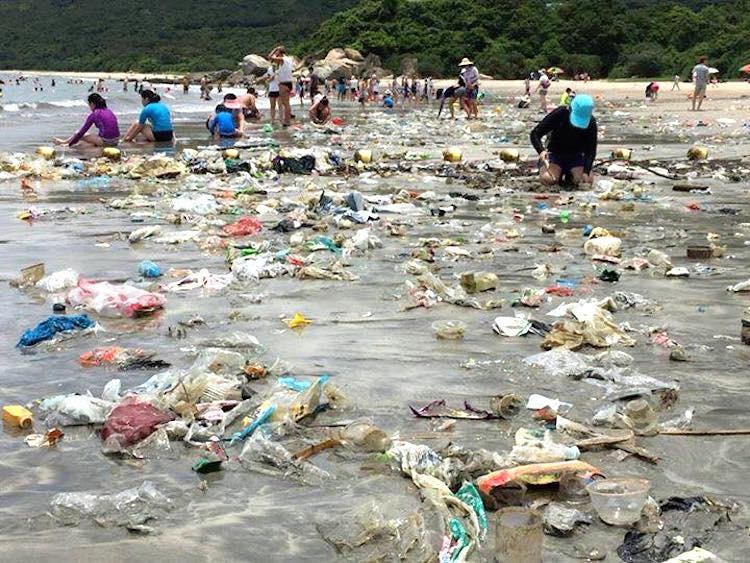- Bernard Preston homepage
- Our green solar power
- Solar Geyser
Solar geyser
A solar geyser provides super-hot water for the home on every sunny day.
Watch out for a tube that has lost its vacuum when installing a cheaper brand of dubious origin. The German array is 40-percent more efficient and has thicker glass in case of hail. We have both kinds, so I can speak with some knowledge.
 Solar geyser
Solar geyserIt has been estimated that roughly a third of the electricity consumed in the modern home is used to heat water; in the shower, washing machine and dishwasher. The single most cost-effective measure you can take to reduce your power bill is to install an efficient solar geyser.
I say efficient as many of them are something less than satisfactory; I recently met a couple who still have to use mains for four hours a day to heat the water for two people. In contrast, if we turn on the geyser for more than thirty minutes a month, and never in winter when it is cloudless, it is a lot.
If we have guests to stay then it may be different.
On the roof
In mild climates with minimal frost it is better to put your solar geyser on the roof. A thermosyphen is far better than in the ceiling with a pump; we had the latter and it was definitely not satisfactory.
The modern solar geyser uses vacuated-tubes with a copper rod down the centre. Heat is trapped within the glass and conducted up the rod to a manifold containing water; it is extremely effective.
One of the great advantages over the old systems is that it is frost-proof down to minus 10 degrees and less. The hot water then by convection rises to the geyser which needs to be placed at least some 60cm above the manifold.
In theory the geyser can be in the ceiling below the manifold, but I do not recommend this. A solar pump must be used; they are noisy, expensive and do not last very long; if the plastic-fitting bursts, as ours did, your house will be flooded.
New building requirements in any event are for geysers to go on the tiles or beside the building; anywhere but in the roof. It is rather unsightly, but it is effective and far more functional; no more flooding of your carpets and ceiling boards.
My recommendation is a 20-tube system; it is only slightly more expensive, and you will have hot water throughout the winter when the sun is lower in the sky.
With a 150-litre geyser, enough for two days, we only rarely turn it on the power, and not usually for more than ten to fifteen minutes; the water actually boils on occasion in summer.
A special geyser is required, with an extra inlet and outlet to the manifold.
Replacing a perfectly good geyser is probably a needless expense; rather start planning now, so that when your existing unit bursts, you are ready to move. They rarely last much more than five years.
My advice is to use the German solar tubes and manifold, supplied by a Pietermaritzburg company that has been in existence for many years; down the grapevine I hear the Australian and Chinese are less effective, but do your own homework.
Fitted, you are looking at about R30,000. Not cheap, but if it reduces your electricity bill by 50 percent, you are looking at a payback time of about three years. After that, your hot water is free.
I say free but what I mean is that the heat comes for no charge; to have abundant pristine water you need to harvest the rain.
Solar electrical backup
The modern solar geysers work extremely well, so efficiently in fact that the water will actually boil on very hot days in summer; especially if you have not had a shower last evening or that morning.
But in winter it is another story; the sun is low in the sky and night temperatures are low. The plus side in our climate is that it is very rarely cloudy or wet. But still if you have a family of five or more you may want a solar electrical backup, or in fact from your prepaid electricity utility account.
There are two ways to do a solar electrical backup.
First the way we did it. It is inexpensive but you must use a high quality change-over switch; the cheap ones just do not last. This only works if you have surplus solar power during the day.
The change-over switch is installed next to the distribution box. Incoming feed comes either from the utility, or from your solar line that is fed directly by your inverter. The return goes to the breaker that supplies your geyser; an hour's work by a qualified electrician.
Our electrician advised in fact using two breakers, one for the solar feed and the other for the utility power which in fact is only rarely used during wet, cloudy weather.
He also recommended first dropping the breaker before engaging the change-over switch to save the terminals.
The second way I have no experience of but it means installing about
900 watts of solar PVs that will supply the geyser with direct current.
The downside of this is that during inclement weather you cannot use the
utility backup which supplies AC. And in summer this extra energy could
be better used to charge your electric car or the air-conditioner perhaps.
Either way, you need to have at least three large extra solar panels to give the water some extra oomph as you approach the winter solstice when the days are short and temperatures lower.
Solar geyser
A solar geyser has a payback time of about three years, using an oft-quoted statistic that half the electricity in the home is used to heat water. We in fact have two houses, so the first was installed fifteen years ago and the second about ten when we added the Gardeners' Cottage. There is no granny flat in our home; I am planning to live there for a long time too! We have had free heating from the sun for many years and they still work perfectly.
It is an enormous privilege to have your grandchildren around you every day.
Have you heard of cyan zones? It is where folk care well for both themselves and the planet, combining the virtues of both blue and green living.
Living the blue zone way really means you can expect to live long in the land, and even hope for a life without medication. That is not a pipe-dream; over seventy neither of us take any drugs for chronic conditions. And in this coronavirus season we do not fear the day our grandchildren will probably bring the bug home from school; perhaps that is naive.
Living the green zone way means the planet too is less ill, but still alas needs a lot of treatment. Weaning off plastic is proving very difficult for humans. This is not my idea of a day at the beach.

When browsing use right click and "Open Link in New Tab" or you may get a bad gateway signal.
Newsletter
Our newsletter is entitled "create a cyan zone" at your home, preserving both yourself and Mother Earth for future generations; and the family too, of course. We promise not to spam you with daily emails promoting various products. You may get an occasional nudge to buy one of my books.
Here are the back issues.
- Lifestyle and ideal body weight
- What are ultra-processed foods?
- Investing in long-term health
- Diseases from plastic exposure
- Intensive lifestyle management for obesity has limited value
- A world largely devoid of Parkinson's Disease
- The impact of friendly bacteria in the tum on the prevention of cancer
- There's a hole in the bucket
- Everyone is talking about weight loss drugs
- Pull the sweet tooth
- If you suffer from heartburn plant a susu
- Refined maize meal and stunting
- Should agriculture and industry get priority for water and electricity?
- Nature is calling
- Mill your own flour
- Bake your own sourdough bread
- Microplastics from our water
- Alternative types of water storage
- Wear your clothes out
- Comfort foods
- Create a bee-friendly environment
- Go to bed slightly hungry
- Keep bees
- Blue zone folk are religious
- Reduce plastic waste
- Family is important
- What can go in compost?
- Grow broad beans for longevity
- Harvest and store sunshine
- Blue zone exercise
- Harvest and store your rainwater
- Create a cyan zone at your home
Did you find this page interesting? How about forwarding it to a friendly book or food junkie? Better still, a social media tick would help.
- Bernard Preston homepage
- Our green solar power
- Solar Geyser
Address:
56 Groenekloof Rd,
Hilton, KZN
South Africa
Website:
https://www.bernard-preston.com